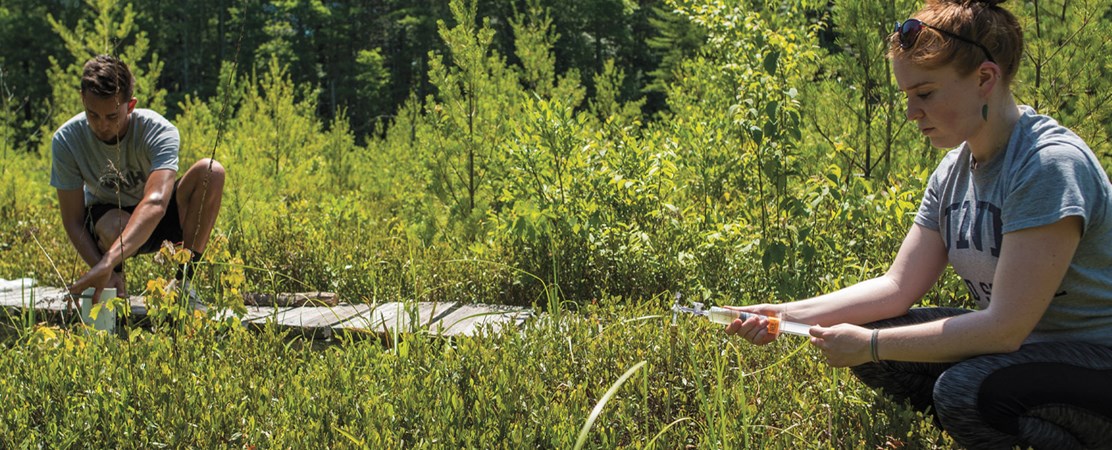It Takes a Village

By Colleen Flaherty, Communications & Information Coordinator and Rebecca Irelan, Communications Manager and Cameron Wake, Research Professor, University of New Hampshire
If you told 18-year-old Kendall Gray she would present her research on her university’s energy infrastructure alongside University of New Hampshire (UNH) president James Dean, she would not have believed you. But that is exactly where 21-year-old Kendall found herself in October 2019 at the announcement of a partnership between the university and local electric utility, Eversource, to increase energy efficiency and reduce carbon emissions.
“It was wild,” said Gray. “I was the only woman on stage, discussing UNH’s leadership in sustainability and our goal to become carbon neutral before 2050.”
Gray is a great example of how the University of New Hampshire envisions an integrated approach to sustainability education, research, and practice. As a summer 2019 Sustainability Fellow, she worked with university faculty and staff to update the university’s climate action plan. UNH has already reduced its greenhouse gas emissions by 51% below its 2001 baseline. The main campus is also powered by 100% renewable electricity, the majority of which is generated on-campus using local landfill gas. Now, carbon neutrality is the goal, and the hope is to achieve it before 2050. In order to do so, UNH will need to engage a broad range of community members, including students.
“UNH has done amazing work to reduce its emissions. I was inspired by just how much has been done and how dedicated faculty and staff are to sustainability”, said Gray. “My fellowship focused on the largest emissions producer for campus – buildings.” Due to higher technological needs, new buildings at UNH consume 33–38% more energy compared to older buildings. Gray’s findings recommend updated planning, design, and construction guidelines that incorporate the cost of carbon into planning, budgeting, and operations. The university is working to implement Gray’s findings.
Kendall Gray is not the only UNH student whose research supports a resilient community in the face of the climate crisis. Clarice Perryman, a PhD student in UNH’s Natural Resources and Earth System Science PhD program, investigates greenhouse gas emissions from thawing permafrost in the Arctic and from peatland bogs in New Hampshire. “In a few decades, those Arctic, boreal peatlands may look pretty similar to the New Hampshire peatland bogs due to climate change,” Perryman explains. More specifically, she studies the role that bacteria called methanotrophs play. These bacteria can consume methane, potentially prevent a fraction of the gas from entering the atmosphere, and thus reduce the contribution to climate change.
Like Gray, Perryman knows the value of her research lies in the action it spurs. She is passionate about discussing her research and climate change with state and national lawmakers. After the 2016 US presidential election, scientists were concerned that federal websites would be scrubbed of any mention of climate change. Perryman facilitated a “data rescue” event at UNH where volunteers helped archive websites that held climate-related content and data. In the lead-up to the presidential primary elections in 2020, Perryman was selected to participate in the NH Youth Climate and Clean Energy Town Hall, where she asked one of the Democratic candidates about her plan to help the nation transition from fossil fuels to renewable energy sources, and how to help people adapt to new job prospects. “I do believe we need to get off fossil fuels as quickly as possible, but I want to see that happen in a way that’s just for everyone,” Perryman says.
Perryman feels a call to share what she considers the privilege of her educational opportunities, and to help connect the dots on climate change for people who may not think about it on a routine basis.
“People have different priorities, so they don’t always make decisions based on climate change,” she says. “But as someone who very much understands the science behind what is happening, I feel I have an obligation to share what I know, and help people understand the science and what that means for their everyday lives and for the future of their children and families.”
Many university students, faculty and staff echo Perryman’s sense of responsibility. It fuels research and gives university practices a backbone of purpose. Students like Gray and Perryman have taken advantage of an institution that encourages them to apply their education and research to better understand systems and to cooperate with stakeholders to make impactful changes. This nuanced approach to the global climate crisis gives students a sense of hope.
“My parents were concerned that my field of study would be too depressing,” said Gray. “But after working with my mentors, fellows, and other universities, I feel so hopeful. I think we might be able to adapt to and mitigate climate change so everyone can thrive.”
